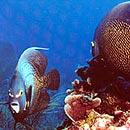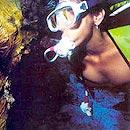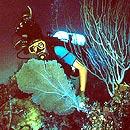Nightly Scuba in the Caribbean
A new discovery; the fear of the unknown; the exuberant marine life that lies in the sea bottom, and that sensation of freedom –coupled with increasingly higher self-confidence in both your skills and potentials- lead you to believing you've finally met your inner self in this seemingly silent world. And I say seemingly because countless noises can be heard under the sea, even some of uncertain origin. People say you can listen to a chewing fish, to an octopus deploying its menacing tentacles, or just hear raindrops splashing on the water surface. Scuba diving could really turn out to be a vital need for you.
As enthused collectors spending fortunes to buy a single mailing stamp, a snail shell, a cigar ring or a particular car make, divers flip thousands of miles under the sea just to steal a look at the Stavronikita –the heaviest wreckage in Caribbean waters (Carlisle Bay)- along the St. James shoreline, or swim through Belize's world-class Blue Hole –an underwater cave featuring astonishing stalactites- and its three huge coral-reef atolls. Scuba diving buffs can equally trek to the Mexican state of Quintana Roo –near Cancun- and drop in on Xcaret Park to visit its most sought-after attraction: the Underground River that flows into the Yucatan watercourse. A trip to the Bahamas with the sole purpose of feeding hungry sharks can also do the trick. On the other hand, taking a swim with jumping dolphins and whales, scouring sunken ships, fishing out treasures –even working in underwater platforms- are adventures in which no hurdles appear too hard to overcome.
The Caribbean is one of the loveliest seas there are for scuba diving. It offers a one-and-only view marked by its gaping beauty, an assorted marine flora and wildlife, miles of crystal-clear waters and a variety of coral reefs that are penciled in as one of the world's largest reserves, second only to Australia's Great Coral Barrier.
Night and Scuba diving: an experience to remember People usually think of a clear, sunny day when talking about this thrilling sport. But, what about diving into Caribbean waters in the middle of the night?
Polls taken among several experts –especially the opinion weighed in by Alfredo Contreras Guitian from the Barracuda International Diving Center in Varadero and those who have read extensively on the matter- reveal this is no doubt a world packed with sensations in which experience and imagination go hand in hand.
There are boatloads of certified divers under the sun and for all of them piercing into the secrets of the ocean is a privilege they just can't pass up. Each try always brings something new: anxiety, skittishness, uncertainty, fear for the unexpected dangers lurking in the depths and curiousness about the reaction to each and every one of those perils. That's why this sport demands great mental and physical fitness, let alone a high concentration level chiefly when it comes to nightly diving. The latter takes plenty of experience and a certification in Open Water Diving or any other similar category.
When you sail to a chosen spot and drop the anchor –after heeding the instructor's advise- you feel as if you were sitting on top of the world. Then, you check your gear, put on your goggles and swimwear, take a deep breath and lunge into the water with your partner in tow. Experts always recommend diving in pairs, mainly when it comes to nightly diving. This particular kind of immersion requires equally special techniques and additional training. Your nighttime diving partner, therefore, serves as a protector, a companion and an underwater watchdog. Even though visibility in Caribbean waters generally rules out the need to tether diving partners to a special wire or cord, in other less clear locations both members must remain together and tied to the end of a rope.
Diving enthusiasts should be familiar with the site they had previously combed in order to avoid unnecessary risks. On the other hand, artificial light is indispensable. When you submerge with a watertight flashlight in hand, you drive all worries off your mind and focus exclusively on this bubble world you've dived into.
The first impulse makes you struggle, wiggle indiscriminately without taking account, for instance, of the fact that too much air in your lungs could make diving even harder. The fact of the matter is that you should know you're moving in a 3-D world that calls for a laid-back attitude. Eventually, you understand there's no need to flap so roughly; just let air in and out of your lungs to swim up and down, or just change the position.
“You imagine that flying is an experience quite similar to what you're going through at that moment. The clearest indication that both your body and spirit are under the water is the tone of your inner voices going down to a whisper. When those voices are completely gone, you begin to feast your eyes on that jaw-dropping spectacle.”
With your senses on the lookout, you start hearing the rare underwater noises of the night as you unearth a new and unique universe where life comes to you in an assortment of colors and shapes.
In broad daylight, many underwater creatures crawling around the sea bottom –like mollusks and sea worms- are usually hidden in crevices, caves, shells or under the rocks. Nightly diving gives you the chance of feeling and glimpsing at the true marine life as scores of species get on the move and come out of their concealment. How many times has a sea cancer moved unnoticed in front of your very eyes? At night, however, this critter stretches its tentacles like a star to take advantage of the undercurrent and feed on bypassing organisms that get stuck in its suckers.
Watching shellfish nightlife is a must-see as most mollusks remain out of sight in daytime. There are shrubs, planktons and other species that glow in the underwater night. They have managed to make the most of lightlessness to tip the balance of nature to their side and put on an incredible show. That's the right time for hundreds of shrimps to come out, for lobsters to stumble out of their dens and hunt from atop the rocks, for gaudy and many-shaped fish to parade. When you shed a beam of light over them and see their eyes glimmering in the dark, that image cannot be beaten even by the craftiest surreal painters.
The night and you also witness the octopuses' show of life, creatures that float freely in the dark and display their true colors after a daylong confinement. Eels, morel eels, countless fish species, devil rays that come on and off, snails that traipse their way across the bottom, barracudas that watch you from a distance, shellfish, a variety of coral reefs, fluorescent seaweeds and much more, things that goad you into believing you're on another planet.
You know you only have a flashlight that sheds a small beam of light, so you're completely unaware of what lies some 10 to 15 feet beyond that. Maybe a huge shark is sneaking up on you and that idea sends chills up and down your spine.
Amid that nightlife, manmade light lets you capture colorfulness. The gray shroud that grows darker as you swim deeper is unveiled and you gaze at a lit world that sways between myth and reality.
On you way up to the surface, you know your world is richer now. You've been seduced by the sea and its sets of textures, shapes and colors.
All of the above is a collection of experiences and sensations lived by professional divers in the Caribbean waters. The one and only Caribbean is a giant scuba diving site for this sport's different modalities. The islands make up a 2,400-km-long arch with peculiar and attractive spots of their own for nightly diving.
The diving site Besides many of the aforesaid sites, there are lots of other equally attractive choices that will lure you for sure.
You may travel to Puerto Rico, with five centuries of history buried in the coral reefs, and plunge into the underwater paradise of the island's east coast where the Caribbean Sea and the Atlantic Ocean are split apart by an array of islets leading to Culebra. There you can dive into the depths and scout a peerless panorama of coral reefs, or perhaps go searching for millenary treasures like the finding of a 500-lb. cannon off Isla Verde that belonged to a vessel that sank during the 1625 Danish invasion of the island. The cannon is currently in display in Fort San Geronimo. You bet these are fascinating adventures, especially in a nightly setting.
Venezuela's Los Roques Archipelago –located in the same arch of islets between Aruba and Curazao- is a genuine diving gem. The submarine tableland has fostered the development of a variety of coral clusters. Here divers will happen on highly dense and compact reefs, isolated colonies of petrified corals and layered slopes with caves leading to the open sea all along the southern barrier. This particular spot harbors almost all of the Caribbean's coral species.
For their part, the Cayman Islands offer the possibility of diving through huge vertical walls –whose edges can be made out from just eight meter deep- full of caves, canyons, tunnels, tropical dunes and schools of tunas among other motley species.
In Cozumel –a national park since 1996 that borders on Cancun- Plancar is one of the most covered areas lying just a couple of kilometers from the coastline and known worldwide as the Great Underwater Canyon. Here you could be lucky enough to spot both red and black corals, an amazing variety of fish, turtles, devil rays, harmless sharks and other species.
Cuba is another unmatchable destination among scuba divers. Hemmed in by peaceful seas and an annual average temperature of 24 degrees Celsius, its 60,000 square kilometers of insular platform boast an abundant marine life: 850 kilometers of gorgeous coral barriers and an eye-popping ecosystem that embraces 778 species. Most of these reefs are perched on the Sabana-Camaguey Archipelago, whose 450 kilometers are considered the world's second-largest coral barrier. In Cienfuegos' Yen Faro Luna, divers can take a peek at the Our Lady of the Caribbean, a 14-meter-high column-shaped coral that ranks as the biggest in all of Central and South America.
Courses and Certifications Along the many regions washed by the Caribbean Sea, trekkers will find agencies, companies and marinas providing an assortment of choices, programs and timetables that even include nightly diving. Waiting right there for you, a team of experts is eager to teach you those techniques you need to open up to new sensations and experience the realm of depths. There are all kinds of certified courses –many of them internationally licensed.
Flipping freely through the sea is very much like flying.
This bubble world you splash into puts worries in the back of your mind and lets you focus on a completely different kind of universe.








































































